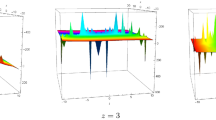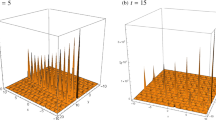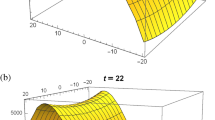Abstract
Solitary waves are localized gravity waves that preserve their consistency and henceforth their visibility by the properties of nonlinear hydrodynamics. In this present work, numerous group-invariant solutions of the (3+1)-dimensional KdV-type equation are derived with the virtue of Lie symmetry analysis. Also, we obtain the corresponding infinitesimal generators, Lie point symmetries, geometric vector fields, commutator table and a one-dimensional optimal system of subalgebras. In addition, two-dimensional optimal system of subalgebra is also obtained using one-dimensional optimal system. Several interesting symmetry reductions and corresponding group-invariant solutions of the equation are obtained based on a one-dimensional optimal system of subalgebras. These group-invariant solutions include special functions like the WeierstrassZeta function, W-shaped solitons, M-shaped solitons, bright-dark solitons, solitary waves and rogue waves which we furnish for the first time for this equation. The physical interpretation of the obtained solutions is discussed graphically based on numerical simulation through Mathematica. Furthermore, nonlocal conservation laws are studied via the Ibragimov approach for Lie point symmetries.






Similar content being viewed by others
References
G.B. Whitham, Linear and Nonlinear Waves (Wiley, New York, 1974)
P.J. Olver, Applications of Lie Groups to Differential Equations (Springer, Berlin, 1991)
G.W. Bluman, S. Kumei, Symmetries and Differential Equations (Springer, Berlin, 1989)
L.V. Ovsiannikov, Group Analysis of Differential Equations (Academic, New York, 1982)
P.J. Olver, P. Rosenau, Group-invariant solutions of differential equations. SIAM J. Appl. Math. 47, 263–278 (1987)
N.H. Ibragimov, A new conservation theorem. J. Math. Anal. Appl. 333, 311–328 (2007)
S.V. Meleshko, Group classification of the equations of two dimensional motions of a gas. J. Appl. Maths. Mech. 58, 629–635 (1994)
N.H. Ibragimov, M. Torrisi, A. Valenti, Preliminary group classification of equations \( v_{tt} = f(x, v_x ) v_{xx} + g(x, v_x ) \). J. Math. Phys. 32, 2988 (1991)
Y. Zhang, W.X. Ma, Rational solutions to a KdV-like equation. Appl. Math. Comp. 256, 252–256 (2015)
F. Batool, G. Akram, New solitary wave solutions of the time-fractional Cahn-Allen equation via the improved \(\left(\frac{G^{\prime }}{G}\right)\)-expansion method. Eur. Phys. J. Plus 133, 171 (2018)
D.J. Korteweg, G. Vries, On the change of form of long waves advancing in a rectangular canal, and on a new type of long stationary wave. Philos. Mag. 39, 422–443 (1895)
A.J. Khattak, A comparative study of numerical solutions of a class of KdV equation. App. Math. Comput. 199, 425–434 (2008)
S.A. Khuri, Soliton and periodic solutions for higher order wave equations of KdV type. Chaos Solitons Fractals 26, 25–32 (2005)
N.J. Zabusky, M.D. Kruskal, Interaction of solitons in a collisionless plasma and the recurrence of initial states. Phys. Rev. Lett. 15, 240–243 (1965)
J.M. Miles, Solitary waves. Ann. Rev. Fluid Mech. 12, 11–43 (1980)
O. Darrigol, Worlds of Flow (Oxford University Press, Oxford, 2005)
R. Hirota, The Direct Method in Soliton Theory, 155 (Cambridge University Press, Cambridge, 2004)
M. Wang, Y. Zhou, Z. Li, Application of a homogeneous balance method to exact solutions of nonlinear equations in mathematical physics. Phys. Lett. A 216, 67–75 (1996)
A. Biswas, D. Milovic, Bright and dark solitons of the generalized nonlinear Schrödinger’s equation. Commun. Nonlinear Sci. Numer. Simul. 15, 1473–1484 (2010)
N.A. Kudryashov, Simplest equation method to look for exact solutions of nonlinear differential equations. Chaos Solitons Fractals 24, 1217–1231 (2005)
M. Lakshmanan, P. Kaliappan, Lie transformations, nonlinear evolution equations, and Painlevé forms. J. Math. Phys. 24, 795–806 (1983)
M. Kumar, R. Kumar, A. Kumar, On similarity solutions of Zabolotskaya-Khokhlov equation Comput. Math. Appl. 68, 454–463 (2018)
M. Xu, M. Jia, Exact solutions, symmetry reductions, painlevé test and Bäcklund transformations of a coupled KdV equation. Commun. Theor. Phys. 68, 417–444 (2017)
S. Kumar, D. Kumar, Solitary wave solutions of (3+1)-dimensional extended Zakharov-Kuznetsov equation by Lie symmetry approach Comput. Math. Appl. 77(8), 2096–2113 (2019)
S. Kumar, D. Kumar, A.M. Wazwaz, Group invariant solutions of (3+1)-dimensional generalized B-type Kadomstsev Petviashvili equation using optimal system of Lie subalgebra. Phys. Scr. 94 (2019)
D. Kumar, S. Kumar, Some new periodic solitary wave solutions of (3+1)-dimensional generalized shallow water wave equation by Lie symmetry approach. Comput. Math. Appl. 78, 857–877 (2019)
S. Kumar, A. Kumar, H. Kharbanda, Lie symmetry analysis and generalized invariant solutions of (2+1)-dimensional dispersive long wave (DLW) equations. Phys. Scr. 95 (2020)
D.V. Tanwar, A.M. Wazwaz, Lie symmetries and dynamics of exact solutions of dissipative Zabolotskaya-Khokhlov equation in nonlinear acoustics. Eur. Phys. J. Plus 135, 520 (2020)
S.Y. Lou, Dromion like structures in a (3 + 1) dimensional KdV-type equation. J. Phys. A Math. Gen. 29, 5989–6001 (1996)
A.M. Wazwaz, Soliton solutions for two (3+1)-dimensional non-integrable KdV-type equations. Math. Comp. Mod. 55, 1845–1848 (2012)
W. Hereman, A. Nuseir, Symbolic methods to construct exact solutions of nonlinear partial differential equations. Math. Comput. Simul. 43, 13–27 (1997)
Ö. Ünsal, Complexiton solutions for (3+1)-dimensional KdV-type equation. Comp. Math. Appl. 75(7), 2466–2472 (2018)
N. Liu, Y. Liu, Homoclinic breather wave, rouge wave and interaction solutions for a (3+1)-dimensional KdV-type equation. Phys. Scr. 94 (2018)
J.J. Mao, S.F. Tian, T.T. Zhang, Rogue waves, homoclinic breather waves and soliton waves for a (3+1)-dimensional nonintegrable KdV-type equation. Int. J. Numer. Method H 29, 763–772 (2019)
A.M. Wazwaz, New solutions for two integrable cases of a generalized fifth-order nonlinear equation. Mod. Phys. Lett. B 29, 1550065 (2015)
X. Hu, Y. Li, Y. Chen, A direct algorithm of one dimensional optimal system for the group invariant solutions. J. Math. Phys. 56 (2015)
P. Satapathy, T.R. Sekhar, Optimal system, invariant solutions and evolution of weak discontinuity for isentropic drift flux model. Appl. Math. Comp. 334, 107–116 (2018)
N.H. Ibragimov, Nonlinear self-adjointness and conservation laws. J. Phys. A Math. Theor. 44 (2011)
G. Dieu-donne, C.G.L. Tiofack, A. Seadawy et al., Propagation of W-shaped, M-shaped and other exotic optical solitons in the perturbed Fokas-Lenells equation. Eur. Phys. J. Plus 135, 371 (2020)
S. Kumar, D. Kumar, A. Kumar, Lie symmetry analysis for obtaining the abundant exact solutions, optimal system and dynamics of solitons for a higher-dimensional Fokas equation. Chaos Soliton Fractals 142 (2021)
Author information
Authors and Affiliations
Corresponding author
Ethics declarations
Conflict of interest
None.
Appendix I
Appendix I
where \(A_{ij}\) are given below
Rights and permissions
About this article
Cite this article
Kumar, S., Kumar, D. & Wazwaz, AM. Lie symmetries, optimal system, group-invariant solutions and dynamical behaviors of solitary wave solutions for a (3+1)-dimensional KdV-type equation. Eur. Phys. J. Plus 136, 531 (2021). https://doi.org/10.1140/epjp/s13360-021-01528-3
Received:
Accepted:
Published:
DOI: https://doi.org/10.1140/epjp/s13360-021-01528-3




